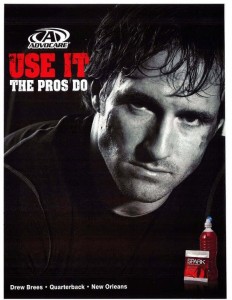Eat in 30
Timing is essential to recovery. The sooner you eat a snack, the better you’ll be able to maximize your recovery. Aim to eat within 30 minutes of ending the game. If you can do it in 10 minutes, even better, says Alvey, a performance nutritionist. You’ll reduce soreness, replenish nutrients, and reduce your risk of injury.
Plan your postgame meal with a blend of carbs and protein. At Git Right we use advocare post workout recovery which provides this powerful combo that will replace glycogen stores (carbs) and rebuild muscles (protein). A general rule of thumb is to consume 0.5-1 g of protein per kilogram of body weight and 1.2 g of carbs per kilogram of body weight. To determine your weight in kilograms, divide your weight in pounds by 2.2. For example, 190 / 2.2 = 86.4 kg x 0.3 = 25 g of protein. Repeat and multiply by 1.2 for carbs (103 g). Note: This is for a player who played the entire game.
Replenishing Fluids
During the course of a football game, players lose valuable fluids that keep their bodies functioning properly. The physical exertion required to perform on the field often leaves players dehydrated at the end of a game. It is important that individuals replace the fluids lost during a game by drinking plenty of water in the hours immediately following a game. In addition, essential electrolytes are also depleted and must be replaced to help retain fluids in the body. Various sports drinks include electrolytes in their formula and are a convenient way to replenish these nutrients. At Git Right we use advocare rehydrate we have found it to work best with our athletes and has the scientific backing as well.
Nursing Strained Muscles
Even the best conditioned athletes suffer form muscle strains due to overuse during a football game. Strained muscles should be treated by applying ice for 20 minutes every hour while awake. Ice helps to reduce pain and swelling associated with muscle strains. Once the swelling has subsided, heat may be used to loosen tight muscles and reduce pain. Never apply ice or heat directly to bare skin; always place a cloth or towel between the skin and application. Aspirin and ibuprofen are effective anti-inflammatory agents and should be taken as needed after a game.
Adequate Rest
It is essential for players recovering from a football game to get adequate rest. Avoid strenuous activities, especially those that use muscle groups that are sore. Getting a good night’s sleep is an important part of recovery for football players. During the night, growth hormone is released from the pituitary gland in the brain. Growth hormone stimulates muscle growth and repair, and helps athletes recover from a tough game. Adequate sleep also helps athletes recover mental sharpness that diminishes with fatigue. We also recommend advocare nighttime recovery for helping the body reach its optimal potential
Foam Roller
Foam rollers are ubiquitous in gyms. They’re so common it’s easy to forget they only skyrocketed to mainstream prominence within the last decade or so. Countless trainers swear by them, and Durkin mentions rollers alongside eating right and stretching as foundations of athletic maintenance.
“It’s something I recommend people do every day,” he says. “It’s simple and it’s effective. If you can take five minutes 2-3 times per day, it really can make a difference for someone who is trying to accelerate healing and recovery. If someone is in pain, then it’s a must.”
The principle behind foam rolling—or other forms of “self-myofascial release”—is remarkably complex, given that it involves such simple and intuitive movements. In short, the pressure of body weight on the roller stimulates the golgi tendon organ, which is located at the junction of muscles and tendons and regulates muscle tension.
This causes a reflexive relaxation of muscles, and can also reputedly help work out tight or painful “trigger points” caused by scarring or muscular adhesions. (If you don’t know what those are, have someone probe around your upper back or calf with their elbow; you’ll know when they find one.)
Aside from those acute benefits, self-myofascial release offers many of the same claims as stretching or massage: improved muscular elasticity, pliability, and range of motion. The latter claim was recently supported by a study at the School of Human Kinetics and Recreation at Memorial University, which determined that self myofascial release “significantly enhanced” knee joint range of motion in a group of healthy, active male subjects without causing any decrease in muscle power or performance.
Of course, foam rollers don’t have the market cornered on self myofascial release. Myofascial release balls—or two tennis or lacrosse balls in a tied-off sock—can achieve basically the same effect, and can actually provide deeper, more direct pressure for those who can handle it. But be warned: Many strong men have been brought to tears by a well-placed tennis ball.
Primary Goals for Immediate Recovery After A Football Game
To provide the depleted body with the proper nutrients to replenish glycogen and electrolyte stores. (Nutrition)
Cooling the body’s core temperature, hydration, and decreasing the production of catabolic hormones. (Nutrition/Cryotherapy)
Decreasing secondary hypoxic injury. Micro tears occur throughout muscle tissue and are the primary cause of DOMS (Delayed Onset Muscle Soreness). Cooling the body’s tissue limits the extent of DOMS by decreasing the tissues need for oxygen and thus limiting secondary hypoxic injury to the micro tears. (Cryotherapy)
Example: Football player after a game
He immediately has an advocare post workout shake, 24 oz of advocare rehydrate, and 24 oz of zero Water.
He then sits in a cold whirlpool 55 degrees F for 5 minutes.
For more info regarding Sports performance recovery or training please feel free to contact us 855-734-4878 or email us at info@Gitrightspf.com
Reference:core performance, pintrest, nutrition consultant Alvey








